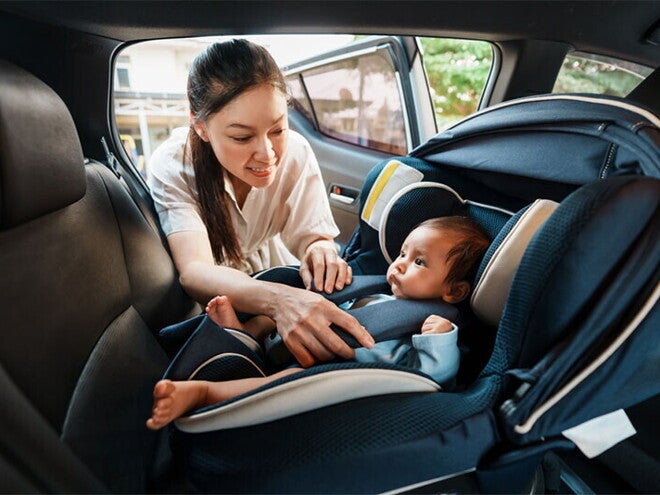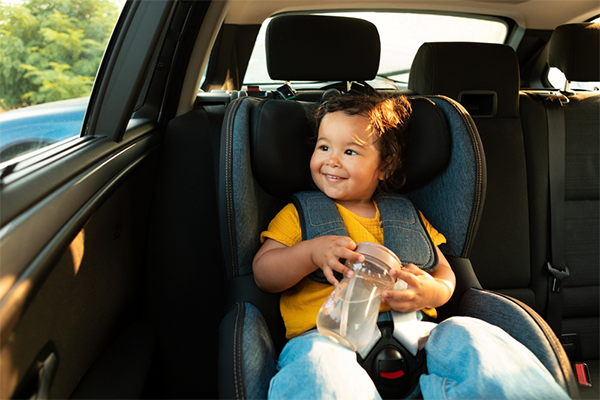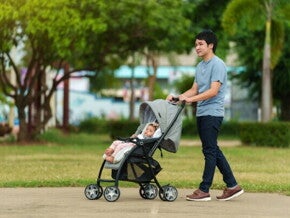
Quiz Time! How Well Do You Know the Car Seat Law in the Philippines?
As a parent, your child's safety in the car is your top priority. That's why understanding the car seat law, also known as the Child Safety in Motor Vehicles Act (RA 11229), is so important. According to the World Health Organization, road traffic injuries are the leading cause of death for children and young adults aged 5 to 29 globally, making this law essential.
Think you know the rules? Take this quick quiz to find out if you’re keeping your little one safe on the road.
1. The Law Requires a Car Seat for Children Aged 7 Years Old and Below
False. Under RA 11229, children 12 years old and below must be in a car seat. The only exception is height. If your child is in this age group but is already taller than 4'11" (150 cm), they may use the seatbelt in the back seat.
2. Children Are Allowed to Sit in the Front Seat if They Wear a Seatbelt
False. Section 5 of RA 11229 explicitly prohibits children 12 years old and younger from sitting in the front seat of any vehicle. The back seat is the safest place for a child since it keeps them away from the force of a deploying frontal airbag, which can cause serious injury.
Your child can only sit in the front seat once they’re taller than 4'11" and the car's seatbelt fits them properly.
3. The Term "Child Restraint System" Only Refers to Car Seats for Infants

Child restraint systems are categorized by a child's age, weight, and height, from rear-facing for infants to booster seats.
False. Child Restraint Systems (CRS) refer to all types of car seats, and the law requires you to use the correct one based on your child’s age, height, and weight. The law uses this broad term because the type of safety seat changes as your child grows.
CRS includes rear-facing seats for infants, forward-facing seats for toddlers and preschoolers, and booster seats for older children.
4. You Should Switch Your Baby to a Forward-Facing Seat When They Turn 1 Year Old
False. Safety experts agree that you should keep your child in a rear-facing car seat for as long as possible, until they reach the maximum height or weight limit allowed by the seat's manufacturer.
A study in the journal Injury Prevention found that for children under 4 years of age, rear-facing seats are more effective at preventing injury in a crash compared to forward-facing seats. This is because it provides the best possible protection for a child's head, neck, and spine in the event of a crash.
5. A Booster Seat Is Just a Cushion to Help a Child See Out the Window
False. A booster seat is a critical safety device. Its purpose is to boost a child up so that the car's seatbelt fits them correctly. A proper fit means the lap belt lies flat across your child's upper thighs (not their soft belly) and the shoulder belt crosses their chest and shoulder.
A regular pillow or cushion can't protect your child since it can cause the seatbelt to ride up and result in a serious injury in a collision.
The US Centers for Disease Control and Prevention (CDC) states that using a booster seat reduces the risk of serious injury in a crash by 45% for children aged 4 to 8 years old compared to using a seatbelt alone.
6. Any Car Seat Bought Abroad Is Acceptable for Use
False. To be compliant, a child car seat in the Philippines must have the proper certification. The law requires the CRS to meet the international safety standards set by the United Nations (either UNECE R44 or the newer UNECE R129).
To check if the car seat meets these standards, look for the Philippine Standard (PS) Safety Mark or an Import Commodity Clearance (ICC) sticker.
Just remember, even the best car seat can fail if you don't install it correctly. A systematic review on CRS use reveals that simple mistakes, such as a loose fit or twisted straps, are a leading cause of injury in motor vehicle crashes.
7. If You’re Just Driving Around Your Village, No Need to Put Your Toddler in a Car Seat

Going on a play date in the same village? Keep your child safe on the road by ensuring they’re securely fastened into a CRS.
False. The law requires a child seat for every trip, no matter how short or slow. Most car accidents actually happen close to home, so using the child restraint system every time is the only way to ensure your child is always protected.
8. The Law Only Applies to Private Vehicles
True. Currently, RA 11229 applies only to private motor vehicles. The Department of Transportation is still studying the feasibility of requiring CRS in public utility vehicles like buses, jeepneys, and vans.
Some ride-sharing services include safety seats for children aged 1 to 7 years old. However, a car seat isn't always readily available. Always check the app for availability or contact the driver beforehand to confirm. You can also consider bringing your own if you have one.
9. A Medical Emergency Is a Valid Reason Not to Use a Car Seat
True. The law provides for certain exemptions during a genuine medical emergency, like when you are rushing a child to the hospital. Or if a child has a medical or developmental condition that makes using a car seat unsafe (you'll need to prove it with a medical certificate).
10. There is No Penalty for Not Using a Car Seat Is Just a Small Fine
False. There are significant penalties for violating the law. While the initial fine may seem manageable, the penalties increase with each succeeding offense. The penalties for violating the child car seat law in the Philippines are:
- First offense: ₱1,000 fine
- Second offense: ₱2,000 fine
- Third and succeeding offenses: ₱5,000 fine and suspension of the driver’s license for one year.
Whether you got every answer right or learned something new, what’s important is your commitment to keeping your child safe. Understanding the specifics of the car seat law can help you make informed decisions and ensure that your little one remains protected on the road.
Connect with other parents on the ParentTeam Moms and Dads Facebook group and share your tips for choosing and using the perfect car seat!
References
Durbin, Dennis R., Benjamin D. Hoffman, and COUNCIL ON INJURY, VIOLENCE, AND POISON PREVENTION. “Child Passenger Safety.” Pediatrics 142, no. 5 (November 2018): e20182460. Accessed July 8, 2025. https://doi.org/10.1542/peds.2018-2460
Giovannini, Elena, Simone Santelli, Guido Pelletti, Maria Paola Bonasoni, Paolo Fais, Angela Cornacchia, and Susi Pelotti. “Pediatric Motor Vehicle Crashes Injuries: A Systematic Review for Forensic Evaluation.” International Journal of Legal Medicine, published online January 22, 2024. Accessed July 8, 2025. https://doi.org/10.1007/s00414-024-03174-7
Land Transportation Office. “MEMORANDUM CIRCULAR NO. 2021-2292: GUIDELINES FOR THE ENFORCEMENT OF REPUBLIC ACT NO. 11229 OR THE 'CHILD SAFETY IN MOTOR VEHICLES ACT'.” October 10, 2023. Accessed July 8, 2025. https://lto.gov.ph/wp-content/uploads/2023/10/MC_2021-2292.pdf
The LAWPhil Project. n.d. “Republic Act No. 11229.” Accessed July 8, 2025. https://lawphil.net/statutes/repacts/ra2019/ra_11229_2019.html
LTO Portal. n.d. “RA 11229: Child Safety in Motor Vehicles Act.” Accessed July 8, 2025. https://ltoportal.ph/ra-11229-child-safety-motor-vehicles-act/
National Safety Council. n.d. “Child Restraint.” Injury Facts. Accessed July 8, 2025. https://injuryfacts.nsc.org/motor-vehicle/occupant-protection/child-restraint/
Philippines. 17th Congress. Republic Act No. 11229. February 22, 2019. https://legacy.senate.gov.ph/lis/bill_res.aspx?congress=17&q=SBN-1971
SAFC. “Child Car Seat Law PH Explained: What’s New and What’s Required.” April 14, 2025. Accessed July 8, 2025. https://safc.com.ph/child-car-seat-law-ph-explained-whats-new-and-whats-required/




























